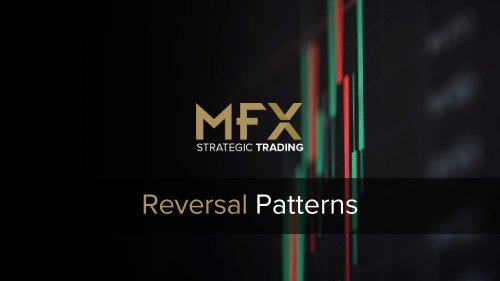MerchantFX Reversal Patterns
There are dozens of bullish and bearish reversal patterns. We have elected to narrow the field by selecting a few of the most popular patterns for detailed explanations.
There are dozens of bullish and bearish reversal patterns. We have elected to narrow the field by selecting a few of the most popular patterns for detailed explanations.
Create successful ePaper yourself
Turn your PDF publications into a flip-book with our unique Google optimized e-Paper software.
<strong>Reversal</strong> <strong>Patterns</strong>
JAPENESE CANDLESTICKS<br />
Every candlestick pattern has four sets of data that help to define its shape.<br />
Analysts are able to make assumptions about price behaviour based on the<br />
shape.<br />
Each candlestick is based on an open, high, low and close.<br />
The time period or tick interval used does not matter.<br />
The filled or hollow bar created by the candlestick pattern is called the<br />
body.<br />
The lines that extend out of the body are called shadows.<br />
An instrument that closes higher than its opening will have a hollow or<br />
green candlestick.<br />
If the instrument closes lower, the body will have a filled or red candlestick.
Technical<br />
Analysis<br />
Japanese Candles
DOJI<br />
One of the most important candlestick formations is<br />
called the Doji.<br />
Doji, referring to both singular and plural form, is created<br />
when the open and close price is virtually the same.<br />
Doji tend to look like a cross or plus sign and have small<br />
or non-existent bodies.<br />
From an auction theory perspective Doji represent<br />
indecision on the side of both buyers and sellers.<br />
Everyone is equally matched, so the price goes nowhere;<br />
buyers and sellers are in a standoff.<br />
Analysts interpret this as a sign of reversal. However, it<br />
may also be a time when buyers or sellers are gaining<br />
momentum for a continuation trend.<br />
Doji are commonly seen in periods of consolidation and<br />
can help analysts identify potential price breakouts.<br />
4
LONG-LEGGED DOJI<br />
The Long-legged Doji is composed of long upper and lower shadows.<br />
FORMATION: Throughout the time period, the price moved up and down dramatically before it<br />
closed at or very near the opening price. This reflects the great indecision that exists between<br />
the bulls and the bears.<br />
SIGNAL: Bearish trend traders look to enter the market after a Long-Legged Doji closes and are<br />
best used on wider timeframes like the daily chart.<br />
DRAGONFLY DOJI<br />
A candle that is formed when the open and closing prices are equal to, or near, the high of the<br />
candle.<br />
FORMATION: Bears begin to sell causing the price to fall. Bullish buyers begin to buy causing the<br />
price to increase.<br />
SIGNAL: If the Dragonfly Doji is found in an downtrend, it may signal a bullish trend reversal when<br />
confirmed by a subsequent bullish candle.<br />
GRAVESTONE DOJI<br />
A candle that is formed when the open and closing prices are equal to, or near, the high of the<br />
candle<br />
FORMATION: Bulls begin to buy causing the price a rally. Bears begin selling causing the price to<br />
decrease.<br />
SIGNAL: If the Gravestone Doji is found in an uptrend, it may signal a bearish trend reversal if<br />
confirmed by a bearish decision candle.
Spinning Top<br />
Bulls and Bears struggle to take control of the price.<br />
The shadows above and below the real body suggests<br />
price action, but the small real body reflects the fact that<br />
there was no real winner in the battle.<br />
The colour of the Spinning Top is irrelevant.<br />
The Spinning Top is a signal of indecision.<br />
6
Bullish & Bearish Spinning Top<br />
7<br />
Spinning Top<br />
Candlestick lines that have small bodies with upper and lower<br />
shadows that exceed the length of the body. Spinning tops signal<br />
indecision.
Engulfing<br />
An engulfing pattern signals a reversal, and can be<br />
bullish or bearish. It comprises two candles. The<br />
body of the second must engulf the body of the<br />
first, and must be the opposite colour to the first.<br />
For a bullish engulfing candle, we have a smaller<br />
red candlestick, followed by a green candlestick,<br />
the body of which is greater in size that the<br />
previous candle.<br />
For a bearish engulfing candle, the first candlestick<br />
is smaller and green, followed by a red candlestick,<br />
the body of which engulfs the previous candle.<br />
8
The Hammer & The Hanging Man<br />
The Hammer<br />
FORMATION: In a downtrend, the sellers push the price to a<br />
level where the buyers step in and begin to lift the price higher.<br />
SIGNAL: If the Hammer is found in an extended downtrend, it<br />
may signal a bullish trend reversal when confirmed by a<br />
subsequent bullish decision candle.<br />
The Hanging Man<br />
FORMATION: In an uptrend, the sellers attempt to gain control of<br />
price by pushing the price down, but the bulls are able to step in<br />
and lift the price higher once again.<br />
SIGNAL: The Hanging Man signals vulnerability to bearish<br />
pressure. For this reason the Hanging Man is a signal of a bearish<br />
reversal if confirmed by a subsequent bearish decision candle.
Inverted Hammer & Shooting Star<br />
These candles are identified by having very small real bodies with little or no shadow to the south, and a<br />
long shadow to the north. The shape of these formations are the same, but it is the location in the trend<br />
that determines whether the formation is a Shooting Star (Bearish) or an Inverted Hammer (Bullish).<br />
Inverted Hammers and Shooting Stars can have green or red<br />
bodies – what’s important here is that the body size is small, that<br />
the upper wick is at least twice the length of the body, and the<br />
lower wick is negligible.<br />
Inverted Hammer<br />
A one-day bullish reversal pattern. In a downtrend, the open is<br />
lower, then it trades higher, but closes near its open, therefore<br />
looking like an inverted lollipop.<br />
Shooting Star<br />
A single day pattern that can appear in an uptrend. It opens<br />
higher, trades much higher, then closes near its open. It looks just<br />
like the Inverted Hammer except that it is bearish.<br />
10
Three Soldiers & Three Crows<br />
Three White Soldiers<br />
A bullish reversal pattern consisting of three consecutive<br />
long green or white bodies. Each should open within the<br />
previous body and the close should be near the high of the<br />
day.<br />
Three Black Crows<br />
A bearish reversal pattern consisting of three consecutive<br />
long red or black bodies where each day closes at or near<br />
its low and opens within the body of the previous day.<br />
11
Strategic Trading<br />
www.<strong>MerchantFX</strong>.com.au
Double Top<br />
The double top is a frequent price formation at the end of a bull<br />
market.<br />
It appears as two consecutive peaks of approximately the same<br />
price on a price-versus-time chart of a market.<br />
The two peaks are separated by a minimum in price, a valley.<br />
The price level of this minimum is called the neck line of the<br />
formation.<br />
The formation is completed and confirmed when the price falls<br />
below the neck line, indicating that further price decline is imminent<br />
or highly likely.<br />
The double top pattern shows that demand is outpacing supply<br />
(buyers predominate) up to the first top, causing prices to rise.<br />
The supply-demand balance then reverses; supply outpaces<br />
demand (sellers predominate), causing prices to fall.<br />
After a price valley, buyers again predominate, and prices rise.<br />
If traders see that prices are not pushing past their level at the first<br />
top, sellers may again prevail, lowering prices and causing a double<br />
top to form.<br />
It is generally regarded as a bearish signal if prices drop below the<br />
neck line.
Double Top<br />
The time between the two peaks is also a determining factor for<br />
the existence of a double top pattern. If the tops appear at the<br />
same level but are very close in time, then the probability is high<br />
that they are part of the consolidation and the trend will resume.<br />
Volume is another indicator for interpreting this formation. Price<br />
reaches the first peak on increased volume then falls down the<br />
valley with low volume. Another attempt on the rally up to the<br />
second peak should be on a lower volume.
Double Bottom<br />
Confirming a Double Bottom Chart Pattern<br />
The double bottom pattern always follows a major or minor down trend in a<br />
particular security, and signals the reversal and the beginning of a potential<br />
uptrend.<br />
Consequently, the pattern should be validated by market fundamentals for the<br />
security itself, as well as the sector that the security belongs to, and the market in<br />
general.<br />
The fundamentals should reflect the characteristics of an upcoming reversal in<br />
market conditions.<br />
Also, volume should be closely monitored during the formation of the pattern.<br />
A spike in volume typically occurs during the two upward price movements in the<br />
pattern.<br />
15<br />
These spikes in volume are a strong indication of upward price pressure and serve<br />
as further confirmation of a successful double bottom pattern.
There is way more to understanding candlestick patterns than<br />
just identifying them it’s about what is going to happen next?<br />
Knowing what is in front of you on the charts, understanding price action, the trend and volatility of the asset class will<br />
put you in the best position possible as the opportunity arises!<br />
BULLS VS BEARS Every candlestick is a battle of the buyers against the sellers. From candlesticks we can see the data<br />
of who is in control who is pulling back.<br />
What will happen next?<br />
“I can’t emphasize enough that we should always look at the bigger picture. a single candlestick alone is not enough.<br />
PAST TRENDS? KEY LEVELS ? PARAMETERS? HIGHS? LOWS? FORMATIONS?”<br />
16<br />
CRAIG MERCHANT
NEVER MISS AN<br />
OPPORTUNITY AGAIN<br />
TRADE ALERTS<br />
QUANT MODELS<br />
KEY CHART LEVELS<br />
LIVE NEWS UPDATES
Head and Shoulders<br />
A Head and Shoulders reversal pattern forms<br />
after an uptrend, and its completion marks a trend<br />
reversal. The pattern contains three successive<br />
peaks with the middle peak (head) being the<br />
highest and the two outside peaks (shoulders)<br />
being low and roughly equal. The reaction lows of<br />
each peak can be connected to form support, or a<br />
neckline.<br />
Inverted Head and Shoulders<br />
18
Prior Trend: It is important to establish the existence of a prior uptrend for this to be a reversal pattern. Without a prior uptrend to reverse, there<br />
cannot be a Head and Shoulders reversal pattern (or any reversal pattern for that matter).<br />
Left Shoulder: While in an uptrend, the left shoulder forms a peak that marks the high point of the current trend. After making this peak, a<br />
decline ensues to complete the formation of the shoulder The low of the decline usually remains above the trend line, keeping the uptrend<br />
intact.<br />
Head: From the low of the left shoulder, an advance begins that exceeds the previous high and marks the top of the head. After peaking, the<br />
low of the subsequent decline marks the second point of the neckline. The low of the decline usually breaks the uptrend line, putting the<br />
uptrend in jeopardy.<br />
Right Shoulder: The advance from the low of the head forms the right shoulder. This peak is lower than the head (a lower high) and usually in<br />
line with the high of the left shoulder. While symmetry is preferred, sometimes the shoulders can be out of whack. The decline from the peak of<br />
the right shoulder should break the neckline.<br />
Neckline: The neckline forms by connecting low points 1 and 2. Low point 1 marks the end of the left shoulder and the beginning of the head.<br />
Low point 2 marks the end of the head and the beginning of the right shoulder. Depending on the relationship between the two low points, the<br />
neckline can slope up, slope down or be horizontal. The slope of the neckline will affect the pattern's degree of bearishness - a downward slope<br />
is more bearish than an upward slope. Sometimes more than one low point can be used to form the neckline.<br />
Support Turned Resistance: Once support is broken, it is common for this same support level to turn into resistance. Sometimes, but certainly<br />
not always, the price will return to the support break, and offer a second chance to sell.<br />
Price Target: After breaking neckline support, the projected price decline is found by measuring the distance from the neckline to the top of the<br />
head. This distance is then subtracted from the neckline to reach a price target. Any price target should serve as a rough guide, and other<br />
factors should be considered as well. These factors might include previous support levels, Fibonacci retracements, or long-term moving<br />
averages
Morning Star<br />
A three-day bullish reversal pattern<br />
consisting of three candlesticks - a longbodied<br />
black candle extending the<br />
current downtrend, a short middle<br />
candle that gapped down on the open,<br />
and a long-bodied white candle that<br />
gapped up on the open and closed<br />
above the midpoint of the body of the<br />
first day.<br />
20
Evening Star<br />
Evening Star<br />
A bearish reversal pattern that continues an<br />
uptrend with a long white body day followed by a<br />
gapped up small body day, then a down close with<br />
the close below the midpoint of the first day<br />
Evening Doji Star<br />
A three-day bearish reversal pattern similar to the<br />
Evening Star. The uptrend continues with a large<br />
white body. The next day opens higher, trades in a<br />
small range, then closes at its open (Doji). The next<br />
day closes below the midpoint of the body of the<br />
first day.<br />
21
Questions to ask yourself while<br />
you do the analysis?<br />
THE CURRENT CANDLE:<br />
The size of the body?<br />
The candle body is a great starting point because we can get a lot of information from it. A long body is showing strength<br />
when bodies become larger it shows momentum . When bodies become smaller, it shows slowing momentum. The body<br />
shows the range over the duration of the candle .<br />
Larger or smaller than the previous ones? Is the size changing meaningful or not?<br />
Is the change happening during an inactive trading period?<br />
For example, candlesticks on EUR pairs they tend to shrink in size during the quieter Asian session.<br />
The length of wicks?<br />
Wicks can show the volatility of price movements. Larger wicks show that price has moved a lot during the duration of<br />
the candle, but it got rejected. When candle wicks become larger it shows an increase in volatility. This often happens<br />
after long trending phases before a reversal happens. Or at major support and resistance levels.
Continued<br />
The ratio between wicks and bodies do you see longer wicks or bodies?<br />
In a high momentum trend, you can often see long bodies with small wicks. When uncertainty<br />
rises, the volatility picks up and bodies become smaller while wicks become larger. The position<br />
of the body this is an extension of the previous point.<br />
Can you see a long wick with a body on the opposite side?<br />
This is often showing a rejection When you have a small body in the middle of a candle with long<br />
wicks, it means indecision<br />
You can see that once we start combining the information that wicks and bodies provide, we can<br />
practically analyse all candlestick formations<br />
23
MFX LIVE TV<br />
https://merchantfx.com.au/live-tv<br />
For more strategies tutorials and in depth analysis follow us on our YouTube channel:<br />
LIVE WEBINARS<br />
WATCH ANYTIME
info@<strong>MerchantFX</strong>.com.au +61 (0) 38 393 1800 www.<strong>MerchantFX</strong>.com.au





